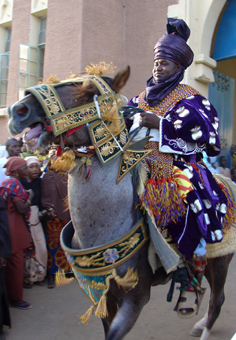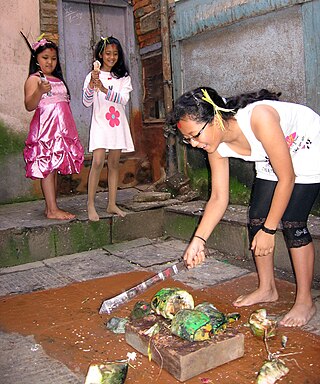
Ghana is a country of 33.48 million people and many native groups, such as:

Gawai Dayak is an annual festival and a public holiday celebrated by the Dayak people in Sarawak, Malaysia on 1 and 2 June. Sarawak Day is now celebrated on July 22 every year. Gawai Dayak was conceived of by the radio producers Tan Kingsley and Owen Liang and then taken up by the Dayak community. The British colonial government refused to recognise Dayak Day until 1962. They called it Sarawak Day for the inclusion of all Sarawakians as a national day, regardless of ethnic origin. It is both a religious and a social occasion recognised since 1957.

The Greater Accra Region has the smallest area of Ghana's 16 administrative regions, occupying a total land surface of 3,245 square kilometres. This is 1.4 per cent of the total land area of Ghana. It is the most populated region, with a population of 5,455,692 in 2021, accounting for 17.7 per cent of Ghana's total population.
The Ga-Dangbe, Ga-Dangme, Ga-Adangme or GaDangme are an ethnic group in Ghana, Togo and Benin. The Ga and Dangbe people are grouped respectively as part of the Ga–Dangme ethnolinguistic group. The Ga-Dangmes are one ethnic group that lives primarily in the Greater Accra region of Ghana. Ethnic Ga family names (surnames) include Nikoi, Amon, Kotey, Kotei, Adei, Adjei, Kutorkor, Oblitey, Lartey, Nortey, Aryee, Obodai, Oboshi, Torgbor, Torshii and Lante. The following are names derived from the ethnic Dangme and common among the Ningos Nartey, Tetteh, Kwei, Kweinor, Kwetey, Narteh, Narh, Dugbatey, Teye, Martey, Addo, Siaw, Saki, Amanor, Djangba. These are aligned to the ethnic Ga as well: Lomo, Lomotey, Tetteh, Ankrah, Tetteyfio, Laryea, Ayitey, Okai, Bortey, Quaye, Quaynor, Ashong, Kotei, Sowah, Odoi, Ablor, Adjetey, Dodoo, Darku and Quartey.
The Efutu are an Akanized Guang people that are the original inhabitants of present-day Ghana. They founded the coastal area about 1390 C.E. The Efutu are found in Awutu, Adina, Senya-Beraku and Winneba and their main occupation is fishing. Like most Guans, they were somewhat absorbed into the greater Akan culture and adopted Akan names via annexing and military campaigns as the Akan were natural warriors. Similar to the Akuapem people of the Eastern Region of Ghana who are ruled by an Akan Abusua but was originally ruled by their own Guan kings. They also have adopted the Fante version of some Akan institutions and the use of some Fante words in their rituals. Before Akanization, the Simpa Kingdom was formed about 1400 AD.

Cherokee society is the culture and societal structures shared by the Cherokee People. It can also mean the extended family or village. The Cherokee people are Indigenous to the mountain and inland regions of the southeastern United States in the areas of present-day North Carolina, and historically in South Carolina, Tennessee, Virginia, and Northern Mountainous areas, now called the Blue Ridge Mountains of Georgia and its lowlands. The majority of the tribe was forcibly removed to Indian Territory in the winter of 1838-1839.
Tai Phake, also known as Phakial or simply Phake, belong to the Tai-speaking indigenous ethnic group living in Dibrugarh district and Tinsukia district of Assam, principally along the areas of Dihing river as well as adjacent parts of Lohit and Changlang district in Arunachal Pradesh. As of 1990, their population stood at 5,000, which consists of less than 250 families.

The Durbar festival is an ancient traditional annual Hausa; cultural, religious and equestrian festival, celebrated as a core part of the Arewa Hausa culture. Durbar has existed for centuries and is as an essential part of Hausa kingdom and Hausa tradition. Durbar is a paramount part of Hausa cultural rites, tradition and history and the Hausa's are renowned in history as ancient horsemen and warriors of the Sahara and the Sahel.

The Buɣim Chuɣu is the first Dagomba festival in the year. It is celebrated in the first month of the Dagomba lunar year, the Bugum Goli, and is celebrated on the ninth day of the month. The festival is celebrated to remember the "lost son of a king" during ancient Dagbon.
The Aboakyer festival is a bushbuck hunting festival celebrated by the people of Winneba in the Central Region of Ghana.
The Asafotufiam Festival is celebrated by the chiefs and peoples of Ada in the Danube East of the Greater Accra region of Ghana. The festival is celebrated in the first week of August every year.
The Fetu Afahye is a festival celebrated by the chiefs and peoples of Cape Coast in the Central region of Ghana. The festival is celebrated on the first Saturday in the month of September every year. The Fetu Afahye is celebrated annually by the Oguaa people of Cape Coast because in the past there was an outbreak of disease among the people that killed many. The people prayed to the gods to help them to get rid of the disease. Thus the festival is celebrated to keep the town clean and to prevent another epidemic befalling the people.
The Odwira festival is celebrated by the chiefs and peoples of Fanteakwa District and Akuapem in the Eastern Region of Ghana. The Odwira Festival is celebrated by the people of Akropong-Akuapim, Aburi, Larteh, and Mamfe. This is celebrated annually in the month of September and October. The festival celebrates a historic victory over the Ashanti in 1826. This was the battle of Katamansu near Dodowa. It was first celebrated in October 1826.

The Hogbetsotso festival(pronounced Hogbechocho) is celebrated by the chiefs and people of Anlo in the Volta Region of Ghana. Some major Anlo towns include Anloga (capital), Keta, Kedzi, Vodza, Whuti, Srogboe, Tegbi, Dzita, Abor, Anlo Afiadenyigba, Anyako, Konu, Alakple, Atsito, Atiavi, Deʋegodo, Atorkor, Tsiame and many other villages. The festival is celebrated annually on the first Saturday in the month of November at Anloga, the customary and ritual capital of the Anlo state. The name of the festival is derived from the Ewe language and translates as the festival of exodus. or "coming from Hogbe (Notsie)". The celebration of the festival was instituted about four decades ago.
Adae Kese Festival is an important albeit rare celebration among the Ashantis in Ghana. There are two main periods for this celebration: one is Awukudae, and the other is Akwasidae. It glorifies the achievements of the Asante kingdom. It was first celebrated to the achievement of statehood of the people, after the war that the Ashantis had their independence, in the Battle of Feyiase which they fought against the people of Denkyira. It is also the occasion when the purification ceremony of Odwira is performed at the burial shrines of ancestral spirits. Generally, this coincides with the harvest season of yam and hence the ritual was also called the "Yam custom" by Europeans. It is celebrated every two weeks by the people in accordance with the calendar of the Akans based on the cycle of forty-two days and nine months in their calendar. The festival is mostly held to climax celebrations of specific achievements and milestones of the people of the Ashanti kingdom. The festival is a day of rest so it is forbidden to work on that day.

Mohani or Mohni is one of the most important festivals among the Newars which involves a packed itinerary of religious services, pilgrimages, family gatherings and outdoor celebrations lasting several days. Special dinners known as Nakhtya, to which all the relatives are invited, continue for weeks later. Mohani is the equivalent of Nepal's biggest festival Dasain, and there are similarities and differences between the two.
Yaa Asantewaa Festival is an annual festival celebrated by the chiefs and peoples of the Ejisu Traditional Area in the Ashanti Region of Ghana. It is usually celebrated in the month of August.
Kwafie Festival is an annual festival celebrated by the chiefs and people of Wenchi in the Bono region and Techiman and in the Bono East Region, which were all formally Brong Ahafo region of Ghana. It is usually celebrated in the month of July. The people of Dormaa, Berekum and Nsoatre also celebrate it in November/ December.







